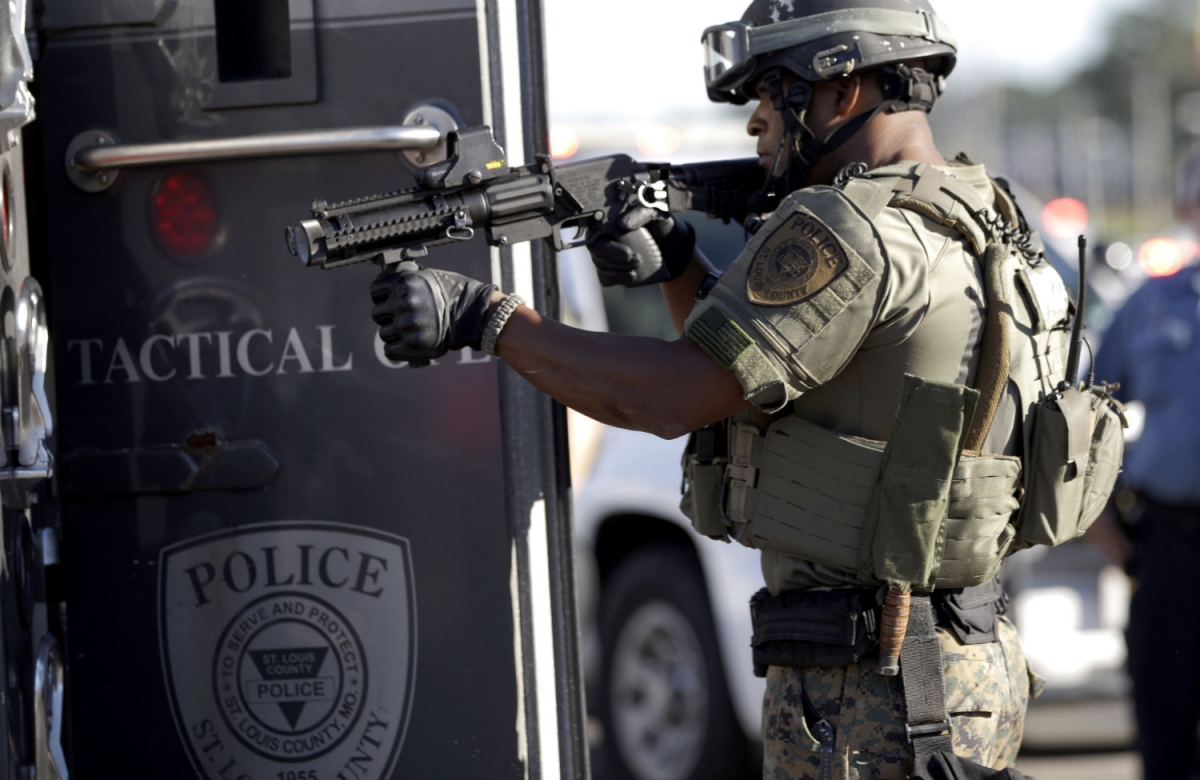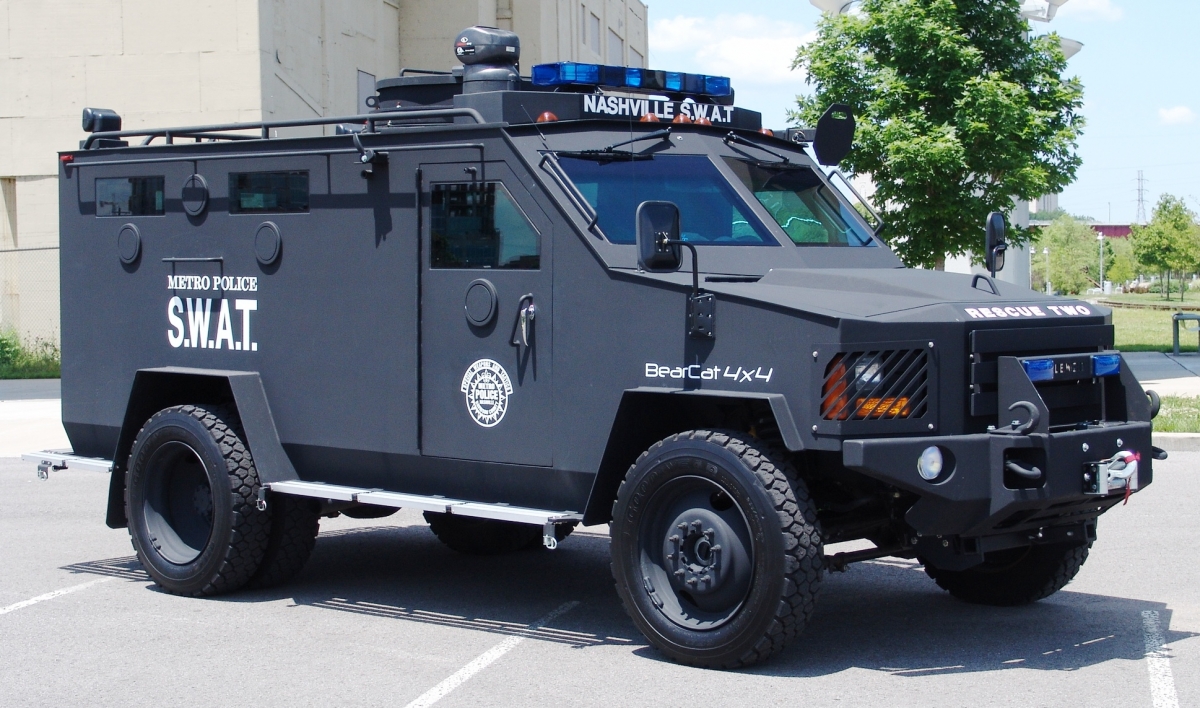As smoke hangs over the streets of Ferguson, Missouri, it’s important to understand its source. Some of this understanding will require us to reassess the history of police militarization in the United States. This will mean acknowledging its origins in the aftermath of the Watts Riots (1965) and the birth of the SWAT team shortly thereafter. It will mean noting the conservative reaction to the Warren Court’s civil libertarian protections in the 1950s and 60s to President Nixon’s launching of the drug war at the end of that same tumultuous decade. It will mean harping on President Reagan’s wholehearted embrace of racial policing and mass incarceration in the 1980s. It will mean interrogating the devastating effects of the 1208 Program (1990), which became the 1033 Program (1996), both of which authorized the transfer of military hardware to domestic precincts, a practice that has only accelerated in the wake of the Battle of Seattle (1999) and the attacks of September 11, 2001. The basic contours of this trajectory can be found in Radley Balko’s Rise of the Warrior Cop: The Militarization of America’s Police Forces (2013). As Tamara K. Nopper and Mariame Kaba argue in Jacobin, however, any serious reckoning must account for the ongoing dehumanization of black people, tout court.
One small way to measure the police violence against black people in Ferguson is to attend to its details. It is in that spirit that I present this simple catalog.
Combat Load

AP Photo/Jeff Roberson
There is a growing chorus of military veterans who have chimed in on the absurdity of photographs like this one. Let me join the parade. What we’re seeing here is a gaggle of cops wearing more elite killing gear than your average squad leader leading a foot patrol through the most hostile sands or hills of Afghanistan. They are equipped with Kevlar helmets, assault-friendly gas masks, combat gloves and knee pads (all four of them), woodland Marine Pattern utility trousers, tactical body armor vests, about 120 to 180 rounds for each shooter, semiautomatic pistols attached to their thighs, disposable handcuff restraints hanging from their vests, close-quarter-battle receivers for their M4 carbine rifles and Advanced Combat Optical Gunsights. In other words, they’re itching for a fight. A big one. It’s a well-known horror that the US military greets foreign peoples in this fashion as our politicians preach freedom, democracy and peace. It’s an abomination that the police greet black communities in the States with the same trigger-happy posture. Especially on the occasion of an unarmed teen’s death by cop.
Smoke Grenade and Smoke Bomb

Reuters/Mario Anzuoni
There’s at least one line every Marine knows. It’s ingrained at boot camp or Officer Candidate School and follows us to the front lines and back home again. It’s a simple command and it’s the second of the four weapons-safety rules. It says, “Never point a weapon at anything you do not intend to shoot.” The St. Louis County Police Department apparently never received the memo. Either that or they intend to shoot. Although their tactical flashlights might be assisting them in spying on (and blinding) their targets, I suspect their air-purifying respirators and the smoke and CS gas they’ve released might be getting in the way of said objective. It’s unclear whether it was cheap fuse-operated smoke bombs (think fireworks) or more expensive pin-operated smoke grenades that are responsible for the fog. Both tools have been reported onsite. For what it’s worth, such smokescreens are usually executed during flanking attacks, retreats, close air support missions or casualty evacuations. All of these situations are presumed to take place under real or potential conditions of heavy enemy fire. Make of this what you will. My guess is that they’ve got a surplus of toys to play with, and a powerless demographic to experiment on.
Popular
"swipe left below to view more authors"Swipe →
Stun Grenade

AP Photo/Jeff Roberson
There are scattered reports of stun grenade use in Ferguson. Also known as flashbangs or flash grenades, this weapon of choice for American SWAT teams (and Israeli soldiers) originated in the British special forces community more than four decades ago. Ostensibly less than lethal, stun grenades have been known to kill or severely injure numerous victims, and the device was recently in the news for burning a 19-month-old baby in Georgia, resulting in a coma, during one of the thousands of domestic police raids this year. They are designed to temporarily blind and deafen, thanks to a shrapnel-free casing that is only supposed to emit light and sound upon explosion. Nonetheless, the list of casualties is long, and the number of flammable mishaps is disconcerting. In Rise of the Warrior Cop, Balko recounts a story of an FBI agent accidentally lighting himself and his vehicle on fire.
Riot Gun

AP Photo/Jeff Roberson
Before moving on to the ammunition most visible in the media, it’s important we consider the machines from which they are being shot. The most likely culprit is the ARWEN 37, which is capable of discharging 37mm tear gas canisters or wooden bullet projectiles. Another possibility is the SL6, a 37mm six-shot rotary magazine projectile launcher that is seemingly capable of firing every relevant “non-lethal” round in the book. When a Marine or other warfighter is introduced to one of these for the first time, he likely thinks of the M203 Grenade Launcher as a point of comparison. This is because they’re all part of the same family. They’re all grenade launchers.
Triple Chaser CS
Picked up this canister of what appears to be tear gas from north end of Florissant tonight. #ferguson pic.twitter.com/dAJZvshwmF
— Zeke Johnson (@ZekeJohnsonAi) August 19, 2014
The police used tear gas unsparingly the past week, and it was perhaps the most disturbing ingredient in the stew. As others have noted, the Chemical Weapons Convention of 1993 actually bans the gas as a permissible means of warfare. Then again, it is allowed for domestic riot control, and nations like Turkey, Bahrain, Israel and the United States have exploited the loophole to great avail. If you’re interested in the weapon’s mechanics or science, the Internet has your back. In the meantime, I can assure you its effects are far from pleasurable. Every Marine has his or her own story about their time at the “gas chamber,” the place we go to become familiar with our gas masks (so they tell us). Suffice it to say it sucks out your organs, hogs your oxygen and burns you inside and out. Interim blindness and extended coughing fits are common, as well as an overall sense that you are dying or dead. And they’re dispersing this poison in people’s backyards.
Pepper Spray Projectile
#Ferguson pepper balls? found in grass at Lang and W Florissant crowd here reported be shot by rubber bullets pic.twitter.com/YOPF8taHX6
— David Carson (@PDPJ) August 12, 2014
St. Louis Post-Dispatch/David Carson
These “pepper balls” are lethal; the Boston Police Department banned them after a young woman was killed by one. It passed right through the eye and skull to the brain. She was guilty of being present in a rowdy crowd after a Red Sox v. Yankees game in which the former won. The ACLU condemned the use of such projectiles for the purposes of crowd management back in 1997, following an unfortunate incident in Eugene, Oregon. They even convinced Eugene officials to do the same. It’s about time St. Louis County and the rest of the country followed suit.
Rubber Bullet
“No injuries” RT @flotusinspired: Just wow….#Ferguson Look at the wound from the rubber bullets! This is terrible. pic.twitter.com/8PGhFq0fze— Jonathan Blanks (@BlanksSlate) August 14, 2014
You can find pictures elsewhere of the kinds of welts these things leave. The key takeaway is that, like so many of the other “safe” items on this list, they disable and kill. It appears the preferred method of discharge in Ferguson is by way of the 60-cal Stinger, which contains approximately 42- or 27 32-caliber rubber balls per casing.
Wooden Bullet Projectile
Brian Schellman of St. Louis PD confirms these were shot at protesters. They are “less lethal wooden baton rounds” pic.twitter.com/5hV2t0cJwo
— Jon Swaine (@jonswaine) August 12, 2014
The Guardian/John Swain
Again, the wounds are nasty. All these injuries remind me of the after-affects of Simunition training for Marine officers at The Basic School, except worse. Like the stun grenade, employing wooden pellets as a form of riot control was spearheaded by the British decades ago, mainly in Hong Kong. As the ACLU makes clear, considerable litigation has proceeded in the aftermath of such tactics, including suits brought by protesters in Oakland who bore the brunt of these measures around the beginning of the Iraq War. Longshoremen on their way to work also suffered and sued accordingly. As a result, the Oakland police department caved and beating residents with wooden projectiles as a means of crowd management was rendered illegal.
Bean Bag Projectile
Found two of (2581 Super Sock) beanbag-round shells. Hadn’t heard of these being used in #furgeson yet. pic.twitter.com/au1hhi4BHw
— Brian Heffernan (@BrianHeff) August 14, 2014
Brian Heffernan
The Super-Sock constitutes yet another less-than-lethal impact munition that kills people. It also happens to have been directed at KSDK-TV photojournalists and Al Jazeera America TV crew members in Ferguson, along with a good dose of tear gas. Numerous suits concerning bean bag usage are also pending.
BEARCAT

Creative Commons/Wikipedia
The BEARCAT G3 is the SWAT team’s version of the military’s Mine Resistant Ambush Protected (MRAP) vehicle, or better yet its MRAP All Terrain Vehicle. Seeing that there aren’t any mines or IEDs in Ferguson, that the chances of an ambush are slim to none, and that the terrain is relatively boring, the decision of the St. Louis County Police Department to roll out with (or even own) one of these is questionable. The same could be said for SWAT teams across the nation, some of whom are presently operating actual MRAPs. As Balko reports in Rise of the Warrior Cop, some are even fitted with 50-caliber machine gun turrets. A rumor in the warfighting community has it that a 50 cal can maim or kill a target even when it misses by a few feet. I don’t think this is true, but it speaks to a certain truth about the gun in question. Why any of this is still allowed anywhere, much less in our neighborhoods (especially in our neighborhoods of color) is beyond me.
Long Range Acoustic Device (LRAD)
Two photos from this evening’s encounter with the SWAT team. It…wasn’t pleasant. pic.twitter.com/TCVqtD1Gni
— Jamelle Bouie (@jbouie) August 14, 2014
Jamelle Bouie
The LRAD is a sonic weapon that my psychological operations (PSYOP) friends could probably discuss more intelligently. All I can tell you is that the sound is so pain-inducing that in addition to being used to keep pirates at bay and break up groups of protesters or black people, it is wielded in order to regulate the movements of wildlife. Here’s how it looks and sounds when targeting human beings.
MD Helicopter 500 Series

Wikipedia
Local police departments no longer just rate military-grade armored personnel carriers and combat loads. They also rate the kinds of helicopters that can only make the North Korean Air Force blush. And one of them presumably spent the middle days of August patrolling Ferguson town folk from the skies. I’m sure they appreciated the service.
K-9

AP Photo/Sid Hastings
Whenever the St. Louis County or Ferguson Police aren’t protecting the public via tear gas, impact munitions or sonic pain, they have been conducting civic outreach by way of growling German shepherds. As a good many military veterans are now lamenting, if cops are going to steal our gadgetry, they might consider adopting our overarching strategy too. Say what you like about Counterinsurgency Doctrine (COIN)—and I’ve said quite a few not-so-nice things about it in the past—but what is taking place in the above photograph spits in the face of everything COIN represents. The point, remember, is to win the hearts and minds of the people, not infuse them with helplessness and rage.
Lord knows we keep failing at this mission overseas. What’s so shocking is that we seem to have abandoned its most decent ideals altogether here at home. As Balko has shown, “community policing grants” have been used to fund more SWAT teams. Any commitments to empathy held by cops has given way to an “Oakleys and crew cuts” bravado that hides behind gargantuan slabs of metal and increasingly deadly ordnance. Most of all, Martin Luther King’s dream is dying a slow death. One officer of the law feels comfortable shouting to the black citizens he is sworn to protect, their iPhone cameras in hand, “Bring it, you fucking animals! Bring it!” This only echoes another quote in Rise of the Warrior Cop, where a SWAT member boasts, “When the soldiers ride in, you should see those blacks scatter.”
The arsenal on display in Ferguson is not the arsenal of riot control. In a town whose population is 67 percent black while its police force is 94 percent white, we are dealing with something more insidious, both locally and as a nation. We are dealing with an arsenal of racial oppression. It’s time we look it in the face, in all its awful detail. It’s time we call it by its name. And it’s time we finally do what we were tasked to do over a half century ago. It’s time we challenge, transcend and extinguish it.


